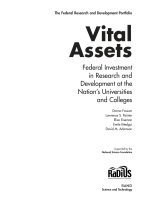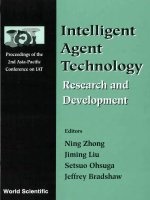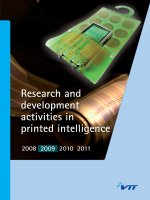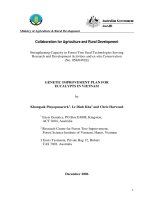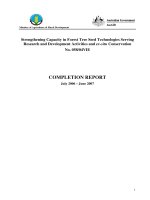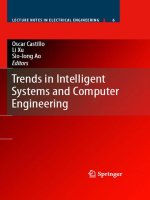Research and development in intelligent systems XXXIII
Bạn đang xem bản rút gọn của tài liệu. Xem và tải ngay bản đầy đủ của tài liệu tại đây (18.56 MB, 381 trang )
Max Bramer
Miltos Petridis Editors
Research and Development
in Intelligent Systems XXXIII
Incorporating Applications and
Innovations in Intelligent Systems XXIV
Proceedings of AI-2016,
The Thirty-Sixth SGAI International
Conference on Innovative Techniques
and Applications of Artificial
Intelligence
Research and Development in Intelligent
Systems XXXIII
Incorporating Applications and Innovations
in Intelligent Systems XXIV
Max Bramer ⋅ Miltos Petridis
Editors
Research and Development
in Intelligent
Systems XXXIII
Incorporating Applications and Innovations
in Intelligent Systems XXIV
Proceedings of AI-2016, The Thirty-Sixth SGAI
International Conference on Innovative Techniques
and Applications of Artificial Intelligence
123
Editors
Max Bramer
School of Computing
University of Portsmouth
Portsmouth
UK
ISBN 978-3-319-47174-7
DOI 10.1007/978-3-319-47175-4
Miltos Petridis
School of Computing, Engineering
and Mathematics
University of Brighton
Brighton
UK
ISBN 978-3-319-47175-4
(eBook)
Library of Congress Control Number: 2016954594
© Springer International Publishing AG 2016
This work is subject to copyright. All rights are reserved by the Publisher, whether the whole or part
of the material is concerned, specifically the rights of translation, reprinting, reuse of illustrations,
recitation, broadcasting, reproduction on microfilms or in any other physical way, and transmission
or information storage and retrieval, electronic adaptation, computer software, or by similar or dissimilar
methodology now known or hereafter developed.
The use of general descriptive names, registered names, trademarks, service marks, etc. in this
publication does not imply, even in the absence of a specific statement, that such names are exempt from
the relevant protective laws and regulations and therefore free for general use.
The publisher, the authors and the editors are safe to assume that the advice and information in this
book are believed to be true and accurate at the date of publication. Neither the publisher nor the
authors or the editors give a warranty, express or implied, with respect to the material contained herein or
for any errors or omissions that may have been made.
Printed on acid-free paper
This Springer imprint is published by Springer Nature
The registered company is Springer International Publishing AG
The registered company address is: Gewerbestrasse 11, 6330 Cham, Switzerland
Programme Chairs’ Introduction
This volume comprises the refereed papers presented at AI-2016, the Thirty-sixth
SGAI International Conference on Innovative Techniques and Applications of
Artificial Intelligence, held in Cambridge in December 2016 in both the technical
and the application streams. The conference was organised by SGAI, the British
Computer Society Specialist Group on Artificial Intelligence.
The technical papers included present new and innovative developments in the
field, divided into sections on Knowledge Discovery and Data Mining, Sentiment
Analysis and Recommendation, Machine Learning, AI Techniques, and Natural
Language Processing. This year’s Donald Michie Memorial Award for the
best-refereed technical paper was won by a paper entitled “Harnessing Background
Knowledge for E-learning Recommendation” by B. Mbipom, S. Craw and
S. Massie (Robert Gordon University, Aberdeen, UK).
The application papers included present innovative applications of AI techniques
in a number of subject domains. This year, the papers are divided into sections on
legal liability, medicine and finance, telecoms and e-Learning, and genetic algorithms in action. This year’s Rob Milne Memorial Award for the best-refereed
application paper was won by a paper entitled “A Genetic Algorithm Based
Approach for the Simultaneous Optimisation of Workforce Skill Sets and Team
Allocation” by A.J. Starkey and H. Hagras (University of Essex, UK), S. Shakya
and G. Owusu (British Telecom, UK).
The volume also includes the text of short papers presented as posters at the
conference.
On behalf of the conference organising committee, we would like to thank all
those who contributed to the organisation of this year’s programme, in particular the
programme committee members, the executive programme committees and our
administrators Mandy Bauer and Bryony Bramer.
Max Bramer, Technical Programme Chair, AI-2016
Miltos Petridis, Application Programme Chair, AI-2016
v
Acknowledgements/Committees
AI-2016 Conference Committee
Prof. Max Bramer, University of Portsmouth (Conference Chair)
Prof. Max Bramer, University of Portsmouth (Technical Programme Chair)
Prof. Miltos Petridis, University of Brighton (Application Programme Chair)
Dr. Jixin Ma, University of Greenwich (Deputy Application Programme Chair)
Prof. Adrian Hopgood, University of Liege, Belgium (Workshop Organiser)
Rosemary Gilligan (Treasurer)
Dr. Nirmalie Wiratunga, Robert Gordon University, Aberdeen (Poster Session
Organiser)
Andrew Lea, Primary Key Associates Ltd. (AI Open Mic and Panel Session
Organiser)
Dr. Frederic Stahl, University of Reading (Publicity Organiser)
Dr. Giovanna Martinez, Nottingham Trent University and Christo Fogelberg
Palantir Technologies (FAIRS 2016)
Prof. Miltos Petridis, University of Brighton and Prof. Thomas Roth-Berghofer
University of West London (UK CBR Organisers)
Mandy Bauer, BCS (Conference Administrator)
Bryony Bramer, (Paper Administrator)
Technical Executive Programme Committee
Prof. Max Bramer, University of Portsmouth (Chair)
Prof. Frans Coenen, University of Liverpool
Dr. John Kingston, University of Brighton
Prof. Dan Neagu, University of Bradford
Prof. Thomas Roth-Berghofer, University of West London
Dr. Nirmalie Wiratunga, Robert Gordon University, Aberdeen
vii
viii
Acknowledgements/Committees
Applications Executive Programme Committee
Prof. Miltos Petridis, University of Brighton (Chair)
Mr. Richard Ellis, Helyx SIS Ltd.
Ms. Rosemary Gilligan, University of Hertfordshire
Dr. Jixin Ma, University of Greenwich (Vice-Chair)
Dr. Richard Wheeler, University of Edinburgh
Technical Programme Committee
Andreas Albrecht (Middlesex University)
Abdallah Arioua (IATE INRA France)
Raed Batbooti (University of Swansea UK (PhD Student), University of Basra
(Lecturer))
Lluís Belanche (Universitat Politecnica de Catalunya, Barcelona, Catalonia, Spain)
Yaxin Bi (Ulster University, UK)
Mirko Boettcher (University of Magdeburg; Germany)
Max Bramer (University of Portsmouth)
Krysia Broda (Imperial College; University of London)
Ken Brown (University College Cork)
Charlene Cassar (De Montfort University UK)
Frans Coenen (University of Liverpool)
Ireneusz Czarnowski (Gdynia Maritime University; Poland)
Nicolas Durand (Aix-Marseille University)
Frank Eichinger (CTS EVENTIM AG & Co. KGaA, Hamburg, Germany)
Mohamed Gaber (Robert Gordon University, Aberdeen, UK)
Hossein Ghodrati Noushahr (De Montfort University, Leicester, UK)
Wael Hamdan (MIMOS Berhad., Kuala Lumpur, Malaysia)
Peter Hampton (Ulster University, UK)
Nadim Haque (Capgemini)
Chris Headleand (University of Lincoln, UK)
Arjen Hommersom (Open University, The Netherlands)
Adrian Hopgood (University of Liège, Belgium)
John Kingston (University of Brighton)
Carmen Klaussner (Trinity College Dublin Ireland)
Ivan Koychev (University of Sofia)
Thien Le (University of Reading)
Nicole Lee (University of Hong Kong)
Anne Liret (British Telecom France)
Fernando Lopes (LNEG-National Research Institute; Portugal)
Stephen Matthews (Newcastle University)
Silja Meyer-Nieberg (Universitat der Bundeswehr Munchen Germany)
Acknowledgements/Committees
Roberto Micalizio (Universita’ di Torino)
Daniel Neagu (University of Bradford)
Lars Nolle (Jade University of Applied Sciences; Germany)
Joanna Isabelle Olszewska (University of Gloucestershire UK)
Dan O’Leary (University of Southern California)
Juan Jose Rodriguez (University of Burgos)
Thomas Roth-Berghofer (University of West London)
Fernando Saenz-Perez (Universidad Complutense de Madrid)
Miguel A. Salido (Universidad Politecnica de Valencia)
Rainer Schmidt (University Medicine of Rostock; Germany)
Frederic Stahl (University of Reading)
Simon Thompson (BT Innovate)
Jon Timmis (University of York)
M.R.C. van Dongen (University College Cork)
Martin Wheatman (Yagadi Ltd.)
Graham Winstanley (University of Brighton)
Nirmalie Wiratunga (Robert Gordon University)
Application Programme Committee
Hatem Ahriz (Robert Gordon University)
Tony Allen (Nottingham Trent University)
Ines Arana (Robert Gordon University)
Mercedes Arguello Casteleiro (University of Manchester)
Ken Brown (University College Cork)
Sarah Jane Delany (Dublin Institute of Technology)
Richard Ellis (Helyx SIS Ltd.)
Roger Evans (University of Brighton)
Andrew Fish (University of Brighton)
Rosemary Gilligan (University of Hertfordshire)
John Gordon (AKRI Ltd.)
Chris Hinde (Loughborough University)
Adrian Hopgood (University of Liege, Belgium)
Stelios Kapetanakis (University of Brghton)
Alice Kerly
Jixin Ma (University of Greenwich)
Lars Nolle (Jade University of Applied Sciences)
Miltos Petridis (University of Brighton)
Miguel A. Salido (Universidad Politecnica de Valencia)
Roger Tait (University of Cambridge)
Richard Wheeler (Edinburgh Scientific)
ix
Contents
Research and Development in Intelligent Systems XXXIII
Best Technical Paper
Harnessing Background Knowledge for E-Learning
Recommendation . . . . . . . . . . . . . . . . . . . . . . . . . . . . . . . . . . . . . . . . . . . . .
Blessing Mbipom, Susan Craw and Stewart Massie
3
Knowledge Discovery and Data Mining
Category-Driven Association Rule Mining . . . . . . . . . . . . . . . . . . . . . . . .
Zina M. Ibrahim, Honghan Wu, Robbie Mallah
and Richard J.B. Dobson
21
A Comparative Study of SAT-Based Itemsets Mining . . . . . . . . . . . . . . .
Imen Ouled Dlala, Said Jabbour, Lakhdar Sais
and Boutheina Ben Yaghlane
37
Mining Frequent Movement Patterns in Large Networks:
A Parallel Approach Using Shapes . . . . . . . . . . . . . . . . . . . . . . . . . . . . . .
Mohammed Al-Zeyadi, Frans Coenen and Alexei Lisitsa
53
Sentiment Analysis and Recommendation
Emotion-Corpus Guided Lexicons for Sentiment Analysis
on Twitter . . . . . . . . . . . . . . . . . . . . . . . . . . . . . . . . . . . . . . . . . . . . . . . . . .
Anil Bandhakavi, Nirmalie Wiratunga, Stewart Massie
and P. Deepak
Context-Aware Sentiment Detection from Ratings . . . . . . . . . . . . . . . . . .
Yichao Lu, Ruihai Dong and Barry Smyth
71
87
Recommending with Higher-Order Factorization Machines . . . . . . . . . . 103
Julian Knoll
xi
xii
Contents
Machine Learning
Multitask Learning for Text Classification with Deep Neural
Networks . . . . . . . . . . . . . . . . . . . . . . . . . . . . . . . . . . . . . . . . . . . . . . . . . . . 119
Hossein Ghodrati Noushahr and Samad Ahmadi
An Investigation on Online Versus Batch Learning in Predicting
User Behaviour . . . . . . . . . . . . . . . . . . . . . . . . . . . . . . . . . . . . . . . . . . . . . . 135
Nikolay Burlutskiy, Miltos Petridis, Andrew Fish, Alexey Chernov
and Nour Ali
A Neural Network Test of the Expert Attractor Hypothesis:
Chaos Theory Accounts for Individual Variance in Learning . . . . . . . . . 151
P. Chassy
AI Techniques
A Fast Algorithm to Estimate the Square Root of Probability
Density Function . . . . . . . . . . . . . . . . . . . . . . . . . . . . . . . . . . . . . . . . . . . . . 165
Xia Hong and Junbin Gao
3Dana: Path Planning on 3D Surfaces . . . . . . . . . . . . . . . . . . . . . . . . . . . 177
Pablo Muñoz, María D. R-Moreno and Bonifacio Castaño
Natural Language Processing
Covert Implementations of the Turing Test: A More Level Playing
Field? . . . . . . . . . . . . . . . . . . . . . . . . . . . . . . . . . . . . . . . . . . . . . . . . . . . . . . 195
D.J.H. Burden, M. Savin-Baden and R. Bhakta
Context-Dependent Pattern Simplification by Extracting
Context-Free Floating Qualifiers . . . . . . . . . . . . . . . . . . . . . . . . . . . . . . . . 209
M.J. Wheatman
Short Papers
Experiments with High Performance Genetic Programming
for Classification Problems . . . . . . . . . . . . . . . . . . . . . . . . . . . . . . . . . . . . . 221
Darren M. Chitty
Towards Expressive Modular Rule Induction for Numerical
Attributes . . . . . . . . . . . . . . . . . . . . . . . . . . . . . . . . . . . . . . . . . . . . . . . . . . . 229
Manal Almutairi, Frederic Stahl, Mathew Jennings,
Thien Le and Max Bramer
OPEN: New Path-Planning Algorithm for Real-World Complex
Environment . . . . . . . . . . . . . . . . . . . . . . . . . . . . . . . . . . . . . . . . . . . . . . . . 237
J.I. Olszewska and J. Toman
Contents
xiii
Encoding Medication Episodes for Adverse Drug Event Prediction . . . . 245
Honghan Wu, Zina M. Ibrahim, Ehtesham Iqbal
and Richard J.B. Dobson
Applications and Innovations in Intelligent Systems XXIV
Best Application Paper
A Genetic Algorithm Based Approach for the Simultaneous
Optimisation of Workforce Skill Sets and Team Allocation. . . . . . . . . . . 253
A.J. Starkey, H. Hagras, S. Shakya and G. Owusu
Legal Liability, Medicine and Finance
Artificial Intelligence and Legal Liability . . . . . . . . . . . . . . . . . . . . . . . . . 269
J.K.C. Kingston
SELFBACK—Activity Recognition for Self-management
of Low Back Pain . . . . . . . . . . . . . . . . . . . . . . . . . . . . . . . . . . . . . . . . . . . . 281
Sadiq Sani, Nirmalie Wiratunga, Stewart Massie
and Kay Cooper
Automated Sequence Tagging: Applications in Financial Hybrid
Systems . . . . . . . . . . . . . . . . . . . . . . . . . . . . . . . . . . . . . . . . . . . . . . . . . . . . 295
Peter Hampton, Hui Wang, William Blackburn and Zhiwei Lin
Telecoms and E-Learning
A Method of Rule Induction for Predicting and Describing Future
Alarms in a Telecommunication Network . . . . . . . . . . . . . . . . . . . . . . . . . 309
Chris Wrench, Frederic Stahl, Thien Le, Giuseppe Di Fatta,
Vidhyalakshmi Karthikeyan and Detlef Nauck
Towards Keystroke Continuous Authentication Using Time Series
Analytics . . . . . . . . . . . . . . . . . . . . . . . . . . . . . . . . . . . . . . . . . . . . . . . . . . . 325
Abdullah Alshehri, Frans Coenen and Danushka Bollegala
Genetic Algorithms in Action
EEuGene: Employing Electroencephalograph Signals in the Rating
Strategy of a Hardware-Based Interactive Genetic Algorithm . . . . . . . . . 343
C. James-Reynolds and E. Currie
Spice Model Generation from EM Simulation Data
Using Integer Coded Genetic Algorithms . . . . . . . . . . . . . . . . . . . . . . . . . 355
Jens Werner and Lars Nolle
xiv
Contents
Short Papers
Dendritic Cells for Behaviour Detection in Immersive Virtual Reality
Training . . . . . . . . . . . . . . . . . . . . . . . . . . . . . . . . . . . . . . . . . . . . . . . . . . . . 371
N.M.Y. Lee, H.Y.K. Lau, R.H.K. Wong, W.W.L. Tam
and L.K.Y. Chan
Interactive Evolutionary Generative Art . . . . . . . . . . . . . . . . . . . . . . . . . . 377
L. Hernandez Mengesha and C.J. James-Reynolds
Incorporating Emotion and Personality-Based Analysis
in User-Centered Modelling . . . . . . . . . . . . . . . . . . . . . . . . . . . . . . . . . . . . 383
Mohamed Mostafa, Tom Crick, Ana C. Calderon
and Giles Oatley
An Industrial Application of Data Mining Techniques
to Enhance the Effectiveness of On-Line Advertising . . . . . . . . . . . . . . . . 391
Maria Diapouli, Miltos Petridis, Roger Evans
and Stelios Kapetanakis
Research and Development in Intelligent
Systems XXXIII
Best Technical Paper
Harnessing Background Knowledge
for E-Learning Recommendation
Blessing Mbipom, Susan Craw and Stewart Massie
Abstract The growing availability of good quality, learning-focused content on the
Web makes it an excellent source of resources for e-learning systems. However,
learners can find it hard to retrieve material well-aligned with their learning goals
because of the difficulty in assembling effective keyword searches due to both an
inherent lack of domain knowledge, and the unfamiliar vocabulary often employed
by domain experts. We take a step towards bridging this semantic gap by introducing
a novel method that automatically creates custom background knowledge in the form
of a set of rich concepts related to the selected learning domain. Further, we develop
a hybrid approach that allows the background knowledge to influence retrieval in the
recommendation of new learning materials by leveraging the vocabulary associated
with our discovered concepts in the representation process. We evaluate the effectiveness of our approach on a dataset of Machine Learning and Data Mining papers
and show it to outperform the benchmark methods.
Keywords Knowledge Discovery · Recommender Systems · eLearning Systems ·
Text Mining
1 Introduction
There is currently a large amount of e-learning resources available to learners on the
Web. However, learners have insufficient knowledge of the learning domain, and are
not able to craft good queries to convey what they wish to learn. So, learners are
B. Mbipom · S. Craw · S. Massie (B)
School of Computing Science and Digital Media, Robert Gordon University,
Aberdeen, UK
e-mail:
B. Mbipom
e-mail:
S. Craw
e-mail:
© Springer International Publishing AG 2016
M. Bramer and M. Petridis (eds.), Research and Development
in Intelligent Systems XXXIII, DOI 10.1007/978-3-319-47175-4_1
3
4
B. Mbipom et al.
often discouraged by the time spent in finding and assembling relevant resources to
meet their learning goals [5]. E-learning recommendation offers a possible solution.
E-learning recommendation typically involves a learner query, as an input; a collection of learning resources from which to make recommendations; and selected
resources recommended to the learner, as an output. Recommendation differs from
an information retrieval task because with the latter, the user requires some understanding of the domain in order to ask and receive useful results, but in e-learning,
learners do not know enough about the domain. Furthermore, the e-learning resources
are often unstructured text, and so are not easily indexed for retrieval [11]. This challenge highlights the need to develop suitable representations for learning resources
in order to facilitate their retrieval.
We propose the creation of background knowledge that can be exploited for
problem-solving. In building our method, we leverage the knowledge of instructors contained in eBooks as a guide to identify the important domain topics. This
knowledge is enriched with information from an encyclopedia source and the output
is used to build our background knowledge. DeepQA applies a similar approach to
reason on unstructured medical reports in order to improve diagnosis [9]. We demonstrate the techniques in Machine Learning and Data Mining, however the techniques
we describe can be applied to other learning domains.
In this paper, we build background knowledge that can be employed in e-learning
environments for creating representations that capture the important concepts within
learning resources in order to support the recommendation of resources. Our method
can also be employed for query expansion and refinement. This would allow learners’ queries to be represented using the vocabulary of the domain with the aim of
improving retrieval. Alternatively, our approach can enable learners to browse available resources through a guided view of the learning domain.
We make two contributions: firstly, the creation of background knowledge for
an e-learning domain. We describe how we take advantage of the knowledge of
experts contained in eBooks to build a knowledge-rich representation that is used to
enhance recommendation. Secondly, we present a method of harnessing background
knowledge to augment the representation of learning resources in order to improve
the recommendation of resources. Our results confirm that incorporating background
knowledge into the representation improves e-learning recommendation.
This paper is organised as follows: Sect. 2 presents related methods used for
representing text; Sect. 3 describes how we exploit information sources to build our
background knowledge; Sect. 4 discusses our methods in harnessing a knowledgerich representation to influence e-learning recommendation; and Sect. 5 presents our
evaluation. We conclude in Sect. 6 with insights to further ways of exploiting our
background knowledge.
Harnessing Background Knowledge for E-Learning Recommendation
5
2 Related Work
Finding relevant resources to recommend to learners is a challenge because the
resources are often unstructured text, and so are not appropriately indexed to support
the effective retrieval of relevant materials. Developing suitable representations to
improve the retrieval of resources is a challenging task in e-learning environments [8],
because the resources do not have a pre-defined set of features by which they can be
indexed. So, e-learning recommendation requires a representation that captures the
domain-specific vocabulary contained in learning resources. Two broad approaches
are often used to address the challenge of text representation: corpus-based methods
such as topic models [6], and structured representations such as those that take
advantage of ontologies [4].
Corpus-based methods involve the use of statistical models to identify topics from
a corpus. The identified topics are often keywords [2] or phrases [7, 18]. Coenen
et al. showed that using a combination of keywords and phrases was better than
using only keywords [7]. Topics can be extracted from different text sources such
as learning resources [20], metadata [3], and Wikipedia [14]. One drawback of the
corpus-based approach is that, it is dependent on the document collection used, so
the topics produced may not be representative of the domain. A good coverage of
relevant topics is required when generating topics for an e-learning domain, in order
to offer recommendations that meet learners’ queries which can be varied.
Structured representations capture the relationships between important concepts
in a domain. This often entails using an existing ontology [11, 15], or creating a new
one [12]. Although ontologies are designed to have a good coverage of their domains,
the output is still dependent on the view of its builders, and because of handcrafting,
existing ontologies cannot easily be adapted to new domains. E-learning is dynamic
because new resources are becoming available regularly, and so using fixed ontologies
limits the potential to incorporate new content.
A suitable representation for e-learning resources should have a good coverage
of relevant topics from the domain. So, the approach in this paper draws insight
from the corpus-based methods and structured representations. We leverage on a
structured corpus of teaching materials as a guide for identifying important topics
within an e-learning domain. These topics are a combination of keywords and phrases
as recommended in [7]. The identified topics are enriched with discovered text from
Wikipedia, and this extends the coverage and richness of our representation.
3 Background Knowledge Representation
Background knowledge refers to information about a domain that is useful for general understanding and problem-solving [21]. We attempt to capture background
knowledge as a set of domain concepts, each representing an important topic in the
domain. For example, in a learning domain, such as Machine Learning, you would
6
B. Mbipom et al.
Fig. 1 An overview of the background knowledge creation process
find topics such as Classification, Clustering and Regression. Each of these topics
would be represented by a concept, in the form of a concept label and a pseudodocument which describes the concept. The concepts can then be used to underpin
the representation of e-learning resources.
The process involved in discovering our set of concepts is illustrated in Fig. 1.
Domain knowledge sources are required as an input to the process, and we use a
structured collection of teaching materials and an encyclopedia source. We automatically extract ngrams from our structured collection to provide a set of potential
concept labels, and then we use a domain lexicon to validate the extracted ngrams
in order to ensure that the ngrams are also being used in another information source.
The encyclopedia provides candidate pages that become the concept label and discovered text for the ngrams. The output from this process is a set of concepts, each
comprising a label and an associated pseudo-document. The knowledge extraction
process is discussed in more detail in the following sections.
3.1 Knowledge Sources
Two knowledge sources are used as initial inputs for discovering concept labels. A
structured collection of teaching materials provides a source for extracting important
topics identified by teaching experts in the domain, while a domain lexicon provides a
broader but more detailed coverage of the relevant topics in the domain. The lexicon is
Harnessing Background Knowledge for E-Learning Recommendation
Table 1 Summary of eBooks used
Book title and author
Machine learning; Mitchell
Introduction to machine learning; Alpaydin
Machine learning a probabilistic perspective; Murphy
Introduction to machine learning; Kodratoff
Gaussian processes for machine learning; Rasmussen and Williams
Introduction to machine learning; Smola and Vishwanathan
Machine learning, neural and statistical classification; Michie, Spiegelhalter, and
Taylor
Introduction to machine learning; Nilsson
A first encounter with machine learning; Welling
Bayesian reasoning and machine learning; Barber
Foundations of machine learning; Mohri, Rostamizadeh, and Talwalkar
Data mining-practical machine learning tools and techniques; Witten and Frank
Data mining concepts models and techniques; Gorunescu
Web data mining; Liu
An introduction to data mining; Larose
Data mining concepts and techniques; Han and Kamber
Introduction to data mining; Tan, Steinbach, and Kumar
Principles of data mining; Bramer
Introduction to data mining for the life sciences; Sullivan
Data mining concepts methods and applications; Yin, Kaku, Tang, and Zhu
7
Cites
264
2621
1059
159
5365
38
2899
155
7
271
197
27098
244
1596
1371
22856
6887
402
15
23
used to verify that the concept labels identified from the teaching materials are directly
relevant. Thereafter, an encyclopedia source, such as Wikipedia pages, is searched
and provides the relevant text to form a pseudo-document for each verified concept
label. The final output from this process is our set of concepts each comprising a
concept label and an associated pseudo-document.
Our approach is demonstrated with learning resources from Machine Learning
and Data Mining. We use eBooks as our collection of teaching materials; a summary
of the books used is shown in Table 1. Two Google Scholar queries: “Introduction
to data mining textbook” and “Introduction to machine learning textbook” guided
the selection process, and 20 eBooks that meet all of the following 3 criteria were
chosen. Firstly, the book should be about the domain. Secondly, there should be
Google Scholar citations for the book. Thirdly, the book should be accessible. We
use the Tables-of-Contents (TOCs) of the books as our structured knowledge source.
We use Wikipedia to create our domain lexicon because it contains articles for
many learning domains [17], and the contributions of many people [19], so this
provides the coverage we need in our lexicon. The lexicon is generated from 2
Wikipedia sources. First, the phrases in the contents and overview sections of the
8
B. Mbipom et al.
chosen domain are extracted to form a topic list. In addition, a list containing the titles
of articles related to the domain is added to the topic list to assemble our lexicon.
Overall, our domain lexicon consists of a set of 664 Wiki-phrases.
3.2 Generating Potential Domain Concept Labels
In the first stage of the process, the text from the TOCs is pre-processed. We remove
characters such as punctuation, symbols, and numbers from the TOCs, so that only
words are used for generating concept labels. After this, we remove 2 sets of stopwords. First, a standard English stopwords list,1 which allows us to remove common
words and still retain a good set of words for generating our concept labels. Our second stopwords are an additional set of words which we refer to as TOC-stopwords. It
contains: structural words, such as chapter and appendix, which relate to the structure
of the TOCs; roman numerals, such as xxiv and xxxv, which are used to indicate the
sections in a TOC; and words, such as introduction and conclusion, which describe
parts of a learning material and are generic across domains.
We do not use stemming because we found it harmful during pre-processing.
When searching an encyclopedia source with the stemmed form of words, relevant
results would not be returned. In addition, we intend to use the background knowledge
for query refinement, so stemmed words would not be helpful.
The output from pre-processing is a set of TOC phrases. In the next stage, we apply
ngram extraction to the TOC phrases to generate all 1–3 grams across the entire set of
TOC phrases. The output from this process are TOC-ngrams containing a set of 2038
unigrams, 5405 bigrams and 6133 trigrams, which are used as the potential domain
concept labels. Many irrelevant ngrams are generated from the TOCs because we
have simply selected all 1–3 grams.
3.3 Verifying Concept Labels Using Domain Lexicon
The TOC-ngrams are first verified using a domain lexicon to confirm which of the
ngrams are relevant for the domain. Our domain lexicon contains a set of 664 Wikiphrases, each of which is pre-processed by removing non-alphanumeric characters.
The 84 % of the Wiki-phrases that are 1–3 grams are used for verification. The
comparison of TOC-ngrams with the domain lexicon identifies the potential domain
concept labels that are actually being used to describe aspects of the chosen domain
in Wikipedia. During verification, ngrams referring directly to the title of the domain,
e.g. machine learning and data mining, are not included because our aim is to generate
concept labels that describe the topics within the domain. In addition, we intend to
build pseudo-documents describing the identified labels, and so using the title of
1 />
Harnessing Background Knowledge for E-Learning Recommendation
9
the domain would refer to the entire domain rather than specific topics. Overall, a
set of 17 unigrams, 58 bigrams and 15 trigrams are verified as potential concept
labels. Bigrams yield the highest number of ngrams, which indicates that bigrams
are particularly useful for describing topics in this domain.
3.4 Domain Concept Generation
Our domain concepts are generated after a second verification step is applied to
the ngrams returned from the previous stage. Each ngram is retained as a concept
label if all of 3 criteria are met. Firstly, if a Wikipedia page describing the ngram
exists. Secondly, if the text describing the ngram is not contained as part of the
page describing another ngram. Thirdly, if the ngram is not a synonym of another
ngram. For the third criteria, if two ngrams are synonyms, the ngram with the higher
frequency is retained as a concept label while its synonym is retained as part of the
extracted text. For example, 2 ngrams cluster analysis and clustering are regarded
as synonyms in Wikipedia, so the text associated with them is the same. The label
clustering is retained as the concept label because it occurs more frequently in the
TOCs, and its synonym, cluster analysis is contained as part of the discovered text.
The concept labels are used to search Wikipedia pages in order to generate a
domain concept. The search returns discovered text that forms a pseudo-document
which includes the concept label. The concept label and pseudo-document pair make
up a domain concept. Overall, 73 domain concepts are generated. Each pseudodocument is pre-processed using standard techniques such as removal of English
stopwords and Porter stemming [13]. The terms from the pseudo-documents form
the concept vocabulary that is now used to represent learning resources.
4 Representation Using Background Knowledge
Our background knowledge contains a rich representation of the learning domain
and by harnessing this knowledge for representing learning resources, we expect
to retrieve documents based on the domain concepts that they contain. The domain
concepts are designed to be effective for e-learning, because they are assembled from
the TOCs of teaching materials [1]. This section presents two approaches which have
been developed by employing our background knowledge in the representation of
learning resources.
10
B. Mbipom et al.
(a) Term-concept matrix
(b) Term-document matrix
Fig. 2 Term matrices for concepts and documents
(a) Concept-document matrix representation
(b) Document-document similarity
Fig. 3 Document representation and similarity using the ConceptBased approach
4.1 The C ONCEPT BASED Approach
Representing documents with the concept vocabulary allows retrieval to focus on
the concepts contained in the documents. Figures 2 and 3 illustrate the ConceptBased method. Firstly, in Fig. 2, the concept vocabulary, t1 . . . tc , from the pseudodocuments of concepts, C1 . . . Cm , is used to create a term-concept matrix and a
term-document matrix using TF-IDF weighting [16]. In Fig. 2a, ci j is the TF-IDF of
term ti in concept C j , while Fig. 2b shows dik which is the TF-IDF of ti in Dk .
Next, documents D1 to Dn are represented with respect to concepts by computing
the cosine similarity of the term vectors for concepts and documents. The output is
the concept-document matrix shown in Fig. 3a, where y jk is the cosine similarity of
the vertical shaded term vectors for C j and Dk from Fig. 2a, b respectively. Finally,
the document similarity is generated by computing the cosine similarity of conceptvectors for documents. Figure 3b shows z km , which is the cosine similarity of the
concept-vectors for Dk and Dm from Fig. 3a.
Harnessing Background Knowledge for E-Learning Recommendation
(a) Hybrid term-document matrix representation
11
(b) Hybrid document similarity
Fig. 4 Representation and similarity of documents using the Hybrid approach
The ConceptBased approach uses the document representation and similarity
in Fig. 3. By using the ConceptBased approach we expect to retrieve documents
that are similar based on the concepts they contain, and this is obtained from the
document-document similarity in Fig. 3b. A standard approach of representing documents would be to define the document similarity based on the term document
matrix in Fig. 2b, but this exploits the concept vocabulary only. However, in our
approach, we put more emphasis on the domain concepts, so we use the concept
document matrix in Fig. 3a, to underpin the similarity between documents.
4.2 The H YBRID Approach
The Hybrid approach exploits the relative distribution of the vocabulary in the
concept and document spaces to augment the representation of learning resources
with a bigger, but focused, vocabulary. So the TF-IDF weight of a term changes
depending on its relative frequency in both spaces.
First, the concepts, C1 to Cm and the documents we wish to represent, D1 to Dn ,
are merged to form a corpus. Next, a term-document matrix with TF-IDF weighting
is created using all the terms, t1 to tT from the vocabulary of the merged corpus as
shown in Fig. 4a. For example, entry qik is the TF-IDF weight of term ti in Dk . If ti
has a lower relative frequency in the concept space compared to the document space,
then the weight qik is boosted. So, distinctive terms from the concept space will get
boosted. Although the overlap of terms from both spaces are useful for altering the
term weights, it is valuable to keep all the terms from the document space because
this gives us a richer vocabulary. The shaded term vectors for D1 to Dn in Fig. 4a form
a term-document matrix for documents whose term weights have been influenced by
the presence of terms from the concept vocabulary.
Finally, the document similarity in Fig. 4b, is generated by computing the cosine
similarity between the augmented term vectors for D1 to Dn . Entry r jk is the cosine
12
B. Mbipom et al.
similarity of the term vectors for documents, D j and Dk from Fig. 4a. The Hybrid
method exploits the vocabulary in the concept and document spaces to enhance the
retrieval of documents.
5 Evaluation
Our methods are evaluated on a collection of topic-labeled learning resources by
simulating an e-learning recommendation task. We use a collection from Microsoft
Academic Search (MAS) [10], in which the author-defined keywords associated
with each paper identifies the topics they contain. The keywords represent what
relevance would mean in an e-learning domain and we exploit them for judging
document relevance. The papers from MAS act as our e-learning resources, and using
a query-by-example scenario, we evaluate the relevance of a retrieved document
by considering the overlap of keywords with the query. This evaluation approach
allows us to measure the ability of the proposed methods to identify relevant learning
resources. The methods compared are:
• ConceptBased represents documents using the domain concepts (Sect. 4.1).
• Hybrid augments the document representation using a contribution of term
weights from the concept vocabulary (Sect. 4.2).
• BOW is a standard Information Retrieval method where documents are represented
using the terms from the document space only with TF-IDF weighting.
For each of the 3 methods, the documents are first pre-processed by removing English
stopwords and applying Porter stemming. Then, after representation, a similaritybased retrieval is employed using cosine similarity.
5.1 Evaluation Method
Evaluations using human evaluators are expensive, so we take advantage of the
author-defined keywords for judging the relevance of a document. The keywords are
used to define an overlap metric. Given a query document Q with a set of keywords
K Q , and a retrieved document R with its set of keywords K R , the relevance of R to
Q is based on the overlap of K R with K Q . The overlap is computed as:
Overlap(K Q , K R ) =
|K Q ∩ K R |
min |K Q |, |K R |
(1)
We decide if a retrieval is relevant by setting an overlap threshold, and if the overlap
between K Q and K R meets the threshold, then K R is considered to be relevant.
Our dataset contains 217 Machine Learning and Data Mining papers, each being
2–32 pages in length. A distribution of the keywords per document is shown in Fig. 5,
Harnessing Background Knowledge for E-Learning Recommendation
13
Fig. 5 Number of keywords per Microsoft document
Table 2 Overlap of document-keywords and the proportion of data
Overlap coefficient
Number of pairs
Proportion of data (%) Overlap threshold
Zero
Non-zero
20251 (86 %)
3185 (14 %)
10
5
1
0.14
0.25
0.5
where the documents are sorted based on the number of keywords they contain. There
are 903 unique keywords, and 1497 keywords in total.
A summary of the overlap scores for all document pairs is shown in Table 2.
There are 23436 entries for the 217 document pairs, and 20251 are zero, meaning
that there is no overlap in 86 % of the data. So only 14 % of the data have an overlap
of keywords, indicating that the distribution of keyword overlap is skewed. There are
10 % of document pairs with overlap scores that are ≥ 0.14, while 5 % are ≥ 0.25.
The higher the overlap threshold, the more demanding is the relevance test. We
use 0.14 and 0.25 as thresholds, thus avoiding the extreme values that would allow
either very many or few of the documents to be considered as relevant. Our interest
is in the topmost documents retrieved, because we want our top recommendations to
be relevant. We use precision@n to determine the proportion of relevant documents
retrieved:
Pr ecision@n =
|retrieved Documents ∩ r elevant Documents|
n
(2)
where, n is the number of documents retrieved each time, retrievedDocuments is
the set of documents retrieved, and relevantDocuments are those documents that are
considered to be relevant i.e. have an overlap that is greater than the threshold.
